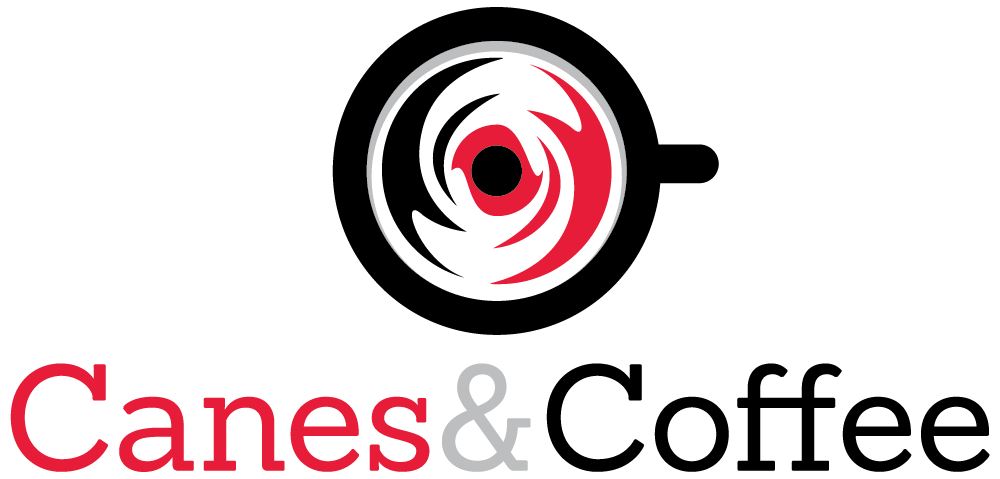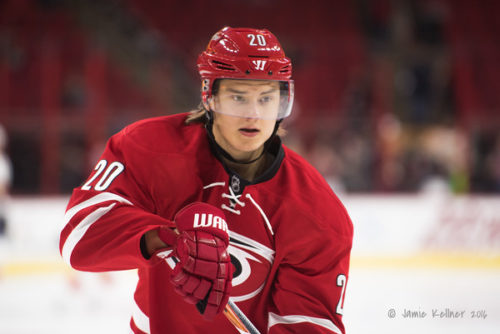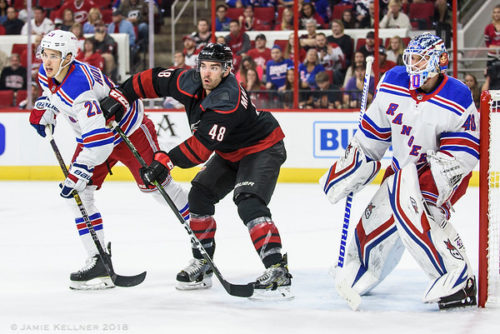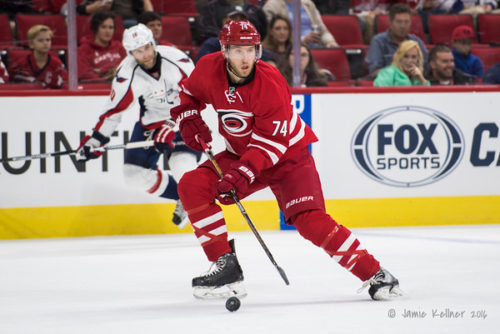Skip below the divider if you just want the on-ice part…
Continuing a good run, Sunday provided another beautiful day for Carolina Hurricanes training camp hockey and the fun of the Caniac Carnival. The atmosphere is always phenomenal between the on-ice action but also the inflatables, giveaways food truck and true carnival atmosphere outside.
I would like to extend a huge thank you to Ashleigh and Cory at Tenco Coffee for offering a convenient pick up and sale point for Canes and Coffee coffee cups at the Caniac Carnival and also for tremendous locally-roasted Counter Culture coffee to help me power through two practices and a long day.
And best part of the day was meeting up with both new and old friends and fellow Caniacs from having a real life Canes and Coffee experience with a small group before the first practice to seeing a few familiar faces to catching a few people carrying Canes and Coffee boxes around to just chatting with the people near me at the practices.
I cannot be happier to be a tiny part of a great hockey community!
On the ice, the day offered two practices. The first saw a mostly veteran group that included all of surefire NHLers and another 6-8 players who presumably earned the chance to sit at the adults table. The second practice was actually the more interesting. The ‘kids’ practice featured enough scrimmage/real hockey type drills that it provided a great evaluation point for many of the prospects.
This article will cover the first practice. I will loop back around either late tonight or otherwise sometime on Monday to share my voluminous notes and thoughts on the prospect practice.
The group
As noted above the first practice session was basically NHL group plus a few borderline players plus a few more players who were presumably being rewarded for what they have done so far.
In addition to the obvious inclusions, the group included Andrew Poturalski, Phil Di Giuseppe, Patrick Brown, Trevor Carrick, Lucas Wallmark and Jeremy Smith. I would take it as a positive consideration-wise that Di Giuseppe, Wallmark and Carrick are practicing with the NHL group. It is less clear to me whether Brown and Poturalski’s inclusion should be interpreted similarly or more as a reward for a couple AHL players or a need to round out numbers for the special teams practice structure. Including AHL goalie Jeremy Smith is clearly a reward of appreciation and not because he is being considered for an NHL role obviously.
Format for the NHL veterans practice
The NHLers practice lasted a little bit over an hour and was about 75 percent focused on special teams. There are few of the use ‘pace and puck movement’ drills at the beginning, but after that Coach Bill Peters pretty quickly moved to a drill focused on the breakout and gaining the offensive zone, a positioning and puck movement drill in the offensive zone, some reversed positioning and explanation time for the penalty killers and finally some actual 5-on-4 play.
The power play structure
Since the start of the 2016-17 training camp, the power play has taken on a decidedly ‘umbrella’ look during practice often with a single defenseman who mostly starts from point middle and two forwards flanking him with a general range of the half boards to a possible shooting position in the general vicinity of the top of the face-off circle. that leaves two ‘low’ forward slots closer to the net with one regularly parked in front of or near the crease and the other also down slow sometimes in a position to short or other times in Elias Lindholm’s office at the side of the net. Interestingly, the real game version of the Hurricanes power play did not always exhibit the same clear umbrella structure and regularly included two defensemen in 2016-17, so it will be interesting to see how it emerges heading into the regular season in a few weeks.
The special teams groups
I had a little trouble figuring out who was where when the play was at the other end of the rink, so someone holler if I mixed someone up and/or read a helmet wrong.
Power play unit A: Skinner/Hanifin/Ryan — Williams/Rask
Power play unit B (at other end): Teravainen/Faulk/Aho — Staal/Lindholm
Penalty kill: Slavin/Pesce — Nordstrom/Kruger
Penalty kill B: Hanifin/Dahlbeck — McGinn/Jooris
There were also groups for the prospect/AHLers.
Goalie day
The goalies in total had a couple runs of stellar play. AHLer Jeremy Smith had a couple consecutive stints where he made a run of a couple quick saves on the same possession that were up to par with the NHLers. Darling looked sharp on Sunday with a good number of saves on shots that looked like goals. And Cam Ward took his turn too.
My most basic impression of Scott Darling thus far is his sheer size. He very much reminds me of Ben Bishop in the sense that when he is upright and out even a tiny bit on a shooter, there looks to be so little to shoot at. I would love to see statistics for ‘big’ goalies like Darling to see how much more frequently shooters miss the net trying to be too fine aiming for tiny openings or even trying to miss the goalie with the shot. There is a simple percentage advantage in terms of bigger goalies just being hit by more pucks, but my non-researched opinion is that they might gain an even bigger advantage by forcing shooters to try to do too much to beat them.
Goalie theory aside, I thought Darling looked very sharp on Sunday. Here is hoping that it carries over into preseason game action this week such that he settles in easily. I thought Ward and Smith were strong as well.
Random other player observations
Justin Williams
Justin Williams just does so many small, heady things that often go unnoticed but can make a significant difference. During the power play work, he had one play where he was the forward in front of the net. The puck went to the forward (Rask) at the side of the net. Just as Rask received the puck, Williams moved his hip, leg and stick into the penalty killer in front of the net such that he sort of put up a barrier and in the process tied up his stick. Sure enough a quarter second later, Rask zipped a pass through the opening and the seam of the penalty kill box. Less than a minute later there was a loose puck on the wall. Instead of taking an angle to the puck, he took an angle quickly to the boards just on the other side of the puck. He had already figured out that a team mate was also headed to the boards, so Williams’ angle basically sealed a penalty killer off, so his team mate could receive the puck with a little time and space to handle it quickly and move it without needing to win it first.
Trevor van Riemsdyk
The proof is in the pudding (which is actually game play), but I really, really like Trevor van Riemsdyk’s skill set conceptually in terms of building any ‘current NHL’ third defense pairing and even more when I consider the likeliest options for his defense partner. Van Riemsdyk is written in pen on the right side of the third defense pairing.
His partner is most likely to be Haydn Fleury. If Fleury does not work out, the safest fallback would be Klas Dahlbeck and his decent set of NHL experience. With Francis (at least so far) choosing not to spend money and a roster spot on experienced veteran defense depth, Trevor Carrick who practiced with the NHL group seems to be the other player in the mix. So when you net it out, the left side of the third pairing is very likely to be either an NHL rookie or Dahlbeck strength is not moving the puck.
Enter van Riemsdyk whose great strength arguably is his ability to advance the puck from his own end. Gone are the NHL days of old where third pairings needed to be big, physical and ideally nasty to stand up to energy lines, agitators and enforcers. In today’s NHL, it is vitally important to have at least one player on the third pairing that can move the puck. Without that, the third pairing gets preyed on in an NHL where teams regularly have four lines that can skate, advance the puck and attack offensively. With slightly less skill on the lower lines, quite often offense is generated by players who can forecheck aggressively, turn over the puck against weaker competition and then capitalize at a reasonable rate.
Van Riemsdyk has the skill set to make the third pairing serviceable or even better at moving the puck out of its own end and slowing down the forecheck with enough puck skills to get the puck behind it if it pins its ears back and charges without regard for positioning and passing lanes.
I found the second practice interesting on a number of players. The practice was a completely different format (not same special teams format as the NHL practice) and featured a bunch of game-like situation drills that were ripe for evaluating the young players. I will post my notes on that practice either Sunday night or midday Monday.
What say you Caniacs?
With a big crowd for the Caniac Carnival certainly others have insights and thoughts on Sunday morning’s practice?
Go Canes!




As well as I know the players I had a hard time telling who was who – maybe I was sitting too high??
First, I like what you write about TvR. I think he paired with Fleury on Day 1 and then Dahlbeck yesterday (with Fleury and Carrick as the 4th pairing). He is going to be such a difference maker in that spot compared to what we had before. The third pairing is solidly better with TvR, regardless of whether left is Dahlbeck or Fleury (I don’t see Carrick on NHL ice).
I was paying a lot of attention to Darling – first time I have seen him in net with the good guys. And I mean with all due respect to both Darling and Bishop – but I used to point out to my daughter (we sit in 129 – the shoot-twice zone so we see a lot of the other team’s goalie) that when Ben Bishop leans over in the crease, his butt hits the bar. Scott Darling has that same skill set. 🙂
What impressed me about Darling was how good he was at keeping pucks out of the net on drills. In particularly he had secondary paddle saves that drew “ooohs” and “aaahs” from the crowd – and rightfully so.